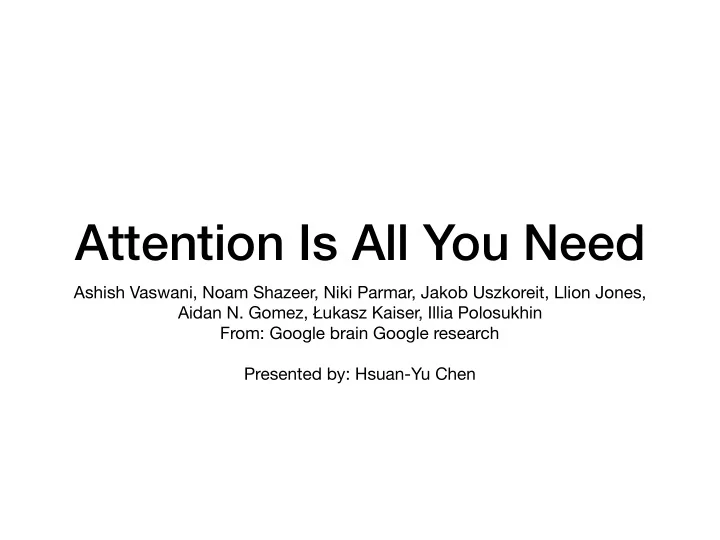

Attention Is All You Need Ashish Vaswani, Noam Shazeer, Niki Parmar, Jakob Uszkoreit, Llion Jones, Aidan N. Gomez, Ł ukasz Kaiser, Illia Polosukhin From: Google brain Google research Presented by: Hsuan-Yu Chen
RNN • Advantages: • State-of-the-art for variable-length representations such as sequences • RNN are considered core of Seq2Seq (with attention) • Problems: • Sequential process prohibits parallelization. Long range dependencies • Sequences-aligned states: hard to model hierarchical-alike domains ex. languages
CNN • Better than RNN (Linear): path length between positions can be logarithmic when using dilated convolutions • Drawback: require a lot of layers to catch long-term dependencies
Attention and Self-Attention • Attention: • Removes bottleneck of Encoder-Decoder model • Focus on important parts • Self-Attention: • all the variables (queries, keys and values) come from the same sequence
Why Self Attention
Transformer Architecture • Encoder: 6 layers of self- attention + feed-forward network • Decoder: 6 layers of masked self-attention and output of encoder + feed- forward
Encoder • N = 6 • All layer output size 512 • Embedding • Positional Encoding • Multi-head Attention • Residual Connection • Position wise feed forward
Positional Encoding • Positional encoding provides relative or absolute position of given token • where pos is the position and i is the dimension
Encoder • N = 6 • All layer output size 512 • Embedding • Positional Encoding • Multi-head Attention • Residual Connection • Position wise feed forward
Scaled Dot Product and Multi-Head Attention
Encoder • N = 6 • All layer output size 512 • Embedding • Positional Encoding • Multi-head Attention • Residual Connection • Position wise feed forward
Residual Connection • LayerNorm(x + Sublayer(x))
Encoder • N = 6 • All layer output size 512 • Embedding • Positional Encoding • Multi-head Attention • Residual Connection • Position wise feed forward
Position Wise Feed Forward • two linear transformation with a ReLU activation in between
Decoder • N = 6 • All layer output size 512 • Embedding • Positional Encoding • Residual Connection: LayerNorm(x + Sublayer(x)) • Multi-head Attention • Position wise feed forward • softmax:
Q, V, K • Queries (Q) come from previous decoder layer, and the memory keys (K) and values (V) come from the output of the encoder • all three come from previous layer (Hidden State)
Training • Data sets: • WMT 2014 English-German: • 4.5 million sentences pairs with 37K tokens. • WMT 2014 English-French: • 36M sentences, 32K tokens. • Hardware: • 8 Nvidia P100 GPus (Base model 12 hours, big model 3.5 days)
Results
More Results
Summary • Introduces a new model, named Transformer • In particular, introduces the concept of multi-head attention mechanism . • It follows a classical encoder + decoder structure . • It is an autoregressive model • Achieves new state-of-the-art results in NMT
Recommend
More recommend